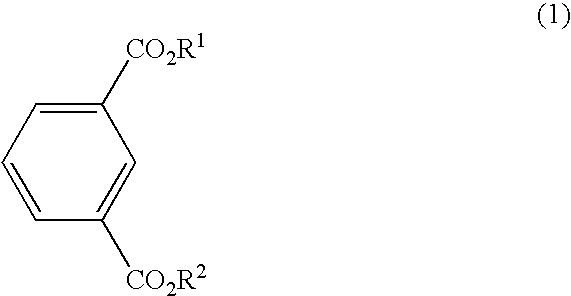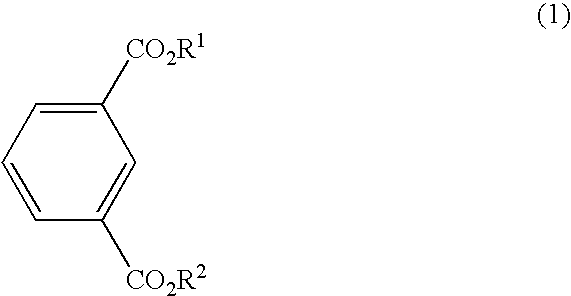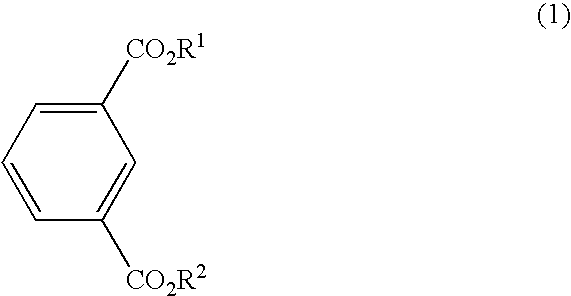Process for the preparing bromoisophthalic acid compound
a bromoisophthalic acid and compound technology, applied in the preparation of carboxylic compounds, organic chemistry, chemistry apparatus and processes, etc., can solve the problems of difficult brominate compounds having electron-attracting groups on their aromatic rings, and give the corresponding compounds only in a low yield, etc., to achieve high yield of recrystallization, light solubility, and high purity
- Summary
- Abstract
- Description
- Claims
- Application Information
AI Technical Summary
Benefits of technology
Problems solved by technology
Method used
Image
Examples
example 1
Into a 50 ml pressure and sealable glass tube, 1.66 g (10 mmol) of isophthalic acid, 6.00 g of 10 wt % fuming sulfuric acid and 1.6 g (10 mmol) of bromine were charged, and the content was stirred at 130° C. for 22 hours. After the conclusion of the reaction, the content was cooled to room temperature, and placed in a beaker containing ice water to give a solid. The resulting solid was filtered off, washed with cooling, and further dried under reduced pressure to give 2.41 g (purity: 83.5%) of a crude crystal of the aimed product (yield: 81.9%). Then, the crystals were solved in 10 g of methanol at 60° C., cooled to room temperature, and thereafter filtered off to give 1.61 g (purity: 100%) of a white crystal (yield of recrystallization: 80.1%). This crystal was identified as 5-bromopisophthalic acid by MASS, 1H-NMR and melting point.
examples 2 to 7
Procedures were carried out similarly to that of Example 1 except that the reaction temperature, the concentration of fuming sulfuric acid and the amount of bromine were changed. The results on the resulting monobromo products were shown in Table 1.
TABLE 1Concentrationof FumingQuantitative Yield (%)Ex.Sulfuric AcidBromineTempera-Time4,5-2,5-No.(wt %)-(g)g(mmol)ture(° C.)(h.)5BIPIPDBIPDBIP210-61.6(10)1102234.558.0trace—320-61.6(10)1102248.643.2trace—430-61.6(10)1102262.824.62.3—510-61.6(10)1502277.04.18.0—620-61.6(10)150753.846.50.7—710-63.2(20)150779.16.45.8traceIP: Isophthalic Acid, 5BIP:5-Bromoisophthalic Acid, 4,5-DBIP: 4,5-Dibromoisophthalic Acid 2,5-DBIP: 2,5-Dibromoisophthalic Acid
example 8
Into a 50 ml pressure and sealable glass tube, 1.66 g (10 mmol) of isopthalic acid, 6.00 g of 30 wt % fuming sulfuric acid and 1.6 g (10 mmol) of bromine were charged, and the content was stirred at 150° C. for 22 hours. After the conclusion of the reaction, the content was cooled to room temperature, and placed in a beaker containing ice water to give a solid. Then, the resulting solid was filtered off, washed with cooling, and further purified by column chromatography on silica gel (chloroform / methanol=6 / 1, v / v) to give 0.51 g (yield: 20.7%) of 5-bromoisophthalic acid, 0.76 g (yield: 23.5%) of 4,5-dibromoisophthalic acid and 0.07 g (yield: 2.1%) of 2,5-dibromoisophthalic acid. These crystals were identified by MASS, 1H-NMR and melting point.
PUM
| Property | Measurement | Unit |
|---|---|---|
| temperature | aaaaa | aaaaa |
| temperature | aaaaa | aaaaa |
| concentration | aaaaa | aaaaa |
Abstract
Description
Claims
Application Information
 Login to View More
Login to View More - R&D
- Intellectual Property
- Life Sciences
- Materials
- Tech Scout
- Unparalleled Data Quality
- Higher Quality Content
- 60% Fewer Hallucinations
Browse by: Latest US Patents, China's latest patents, Technical Efficacy Thesaurus, Application Domain, Technology Topic, Popular Technical Reports.
© 2025 PatSnap. All rights reserved.Legal|Privacy policy|Modern Slavery Act Transparency Statement|Sitemap|About US| Contact US: help@patsnap.com



